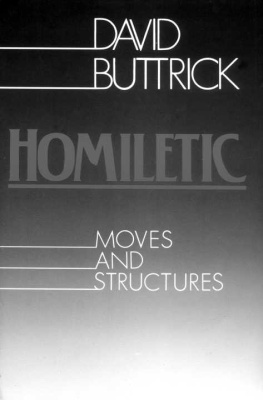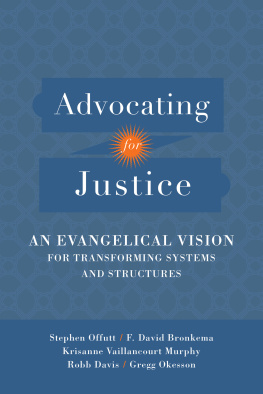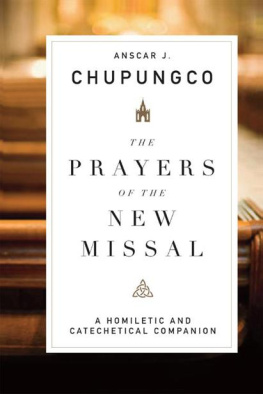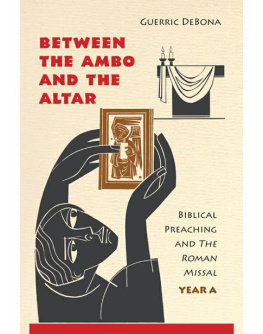David Buttrick - Homiletic Moves and Structures
Here you can read online David Buttrick - Homiletic Moves and Structures full text of the book (entire story) in english for free. Download pdf and epub, get meaning, cover and reviews about this ebook. year: 2008, genre: Religion. Description of the work, (preface) as well as reviews are available. Best literature library LitArk.com created for fans of good reading and offers a wide selection of genres:
Romance novel
Science fiction
Adventure
Detective
Science
History
Home and family
Prose
Art
Politics
Computer
Non-fiction
Religion
Business
Children
Humor
Choose a favorite category and find really read worthwhile books. Enjoy immersion in the world of imagination, feel the emotions of the characters or learn something new for yourself, make an fascinating discovery.
- Book:Homiletic Moves and Structures
- Author:
- Genre:
- Year:2008
- Rating:5 / 5
- Favourites:Add to favourites
- Your mark:
- 100
- 1
- 2
- 3
- 4
- 5
Homiletic Moves and Structures: summary, description and annotation
We offer to read an annotation, description, summary or preface (depends on what the author of the book "Homiletic Moves and Structures" wrote himself). If you haven't found the necessary information about the book — write in the comments, we will try to find it.
Homiletic Moves and Structures — read online for free the complete book (whole text) full work
Below is the text of the book, divided by pages. System saving the place of the last page read, allows you to conveniently read the book "Homiletic Moves and Structures" online for free, without having to search again every time where you left off. Put a bookmark, and you can go to the page where you finished reading at any time.
Font size:
Interval:
Bookmark:



33EIIF4



To RACHEL MATHANA and BENJAMIN ANDREW and their parents ANNE and DAVID

xi
PART 1. MOVES
Words in the World
Moves
Framework
Images
Language
Words in the Church
PART 2. STRUCTURES
Hermeneutics
Homiletics
Structures
Theology
For Further Reading
Phenomenology of Language
Narrative Theology
Recent Rhetorical Studies
Point-of-View
Metaphorical Language
Communication Studies
Black Homiletics
On Language
Style
Homiletic Bibliographies
The Problem of Authority
The Hermeneutical Problem
Narrative Form
Preaching Forms of the Hebrew Scriptures
Preaching Forms of the Christian Scriptures
Recent Homiletic Theory
Theology of Preaching

a Homiletic

Homiletics is an odd discipline. You cannot talk of sermon design without some glimmer of what sermons are made of, and you cannot comprehend the internal parts of a sermon without a grasp of sermon design-a "Homiletic Circle" of sorts. Thus, I have written a homiletic in two parts, Moves and Structures, for you to read in any order you choose. You may begin with part 1, Moves, a study of the components of sermons, and then go on to look at structural theory. Or, you may wish to begin with part 2, Structures, before studying such matters as words and images and ideas. You will have to decide.
Originally, I had planned a work that included chapters on Worship and Preaching as well as chapters on Preaching in the Social World. I have abandoned the plan since the present volume is quite enough for you to wrestle with, much less purchase. Thus, the volume you read will be limited to matters of homiletic design and procedure-the making of sermons. I do not discuss the delivery of sermons, the preacher's character, congregational psychology, or the setting of preaching in worship. There are already books on such matters. The present work, by contrast, is an introductory theoretical-technical homiletic.
I have attempted to do without footnotes and to bypass normal scholarly apparatus so as to keep the style fairly free and easy. Therefore, though the technical information I offer does rest on some years of research, at the risk of dogmatism I neither describe nor document studies. I have, however, provided a selected list of books for those who may wish to explore particular topics.
In any book on homiletics examples are a problem. Ideally, one could wish to draw examples from many different sources so as to display a variety of styles, but it is difficult to locate examples that do exactly what is wanted. As a result, in most cases I have written examples. Please understand that I am not holding my own style up as an ideal; your style will be much better for you.
My approach to homiletics has been described as "phenomenological." The word is cumbersome. I am by no means a schooled phenomenologist. But I am much interested in the way in which language forms in human consciousness. So in both parts I try to describe bow sermons happen in consciousness, your consciousness as a preacher and the attendant consciousness of a congregation. My concern is prompted by a slogan for preachers from Saint Paul: "Faith comes from hearing."
To some, this work may seem unnecessarily prolix. My goal, though, is to understand what may actually take place in consciousness during the production and hearing of sermons. If my conclusions are in any way descriptively "true," then I will have designed a homiletic that will fit your "mind" and the "mind" of a congregation.
I write as a Protestant of the Reformed tradition, although I would not be willing to lay down my life for either term-"Protestant" or "Reformed." In God's strange grace I have taught fourteen years in a Presbyterian seminary, seven years in a Catholic school of theology, and I am now in a nondenominational university-based divinity school. In addition, I have served as a visiting professor with Baptists and Disciples of Christ. We live at a time when God may be dragging us (kicking and screaming) beyond our confessional identities. Therefore, I would hope these pages will be useful to priests and ministers of many traditions. Moreover, I am grateful to colleagues-professors, monks, priests, ministers, and many students-who have taught me to live gleefully beyond my own denominational heritage. Today, we must "sit loose" within our tumbledown confessional homes waiting for God to lead us further.
The homiletics I know has been learned: my father, George Buttrick, and a mentor, Paul Scherer, were influential; kind people in Fredonia, New York, put up with my preaching during parish years; and students, particularly advanced students in Pittsburgh, Saint Meinrad, Louisville, and now in Nashville, have instructed me. From someone, perhaps Schleiermacher, I have gathered the impression that a homiletician ought to be a competent theological dilettante concerned with the church's poetics. I would like to be that, though, I fear, I am somewhat less than competent.
The first chapter in each part was written while I was on the faculty of the Saint Meinrad School of Theology. I wish to thank Archabbot Timothy Sweeney, O.S.B., and President-Rector Daniel Buechlein, O.S.B., for their support. Friends, Bernard Brandon Scott and Edward Farley, were each kind enough to read one of the chapters, and I have gained from their wisdom. A fine homiletician, Lanny Cole Lawler, has read the entire manuscript and offered helpful suggestions.
Time to write has been made possible by grants. I am grateful to the Research Council of Vanderbilt University for an award which has underwritten a year of study free from teaching responsibilities. I am also indebted to the Association of Theological Schools for an additional grant. Dean H. Jackson Forstman of The Divinity School of Vanderbilt University has been unfailing in his support. Christine Scannaliato, a nifty, smart person, has pumped my manuscript pages into a computer with accuracy and remarkable patience. She has even corrected my excessively bad spelling! I am very grateful. Marshall Breeding has prepared the final manuscript, and Annette C. MacBean has expedited the entire project.
Font size:
Interval:
Bookmark:
Similar books «Homiletic Moves and Structures»
Look at similar books to Homiletic Moves and Structures. We have selected literature similar in name and meaning in the hope of providing readers with more options to find new, interesting, not yet read works.
Discussion, reviews of the book Homiletic Moves and Structures and just readers' own opinions. Leave your comments, write what you think about the work, its meaning or the main characters. Specify what exactly you liked and what you didn't like, and why you think so.








